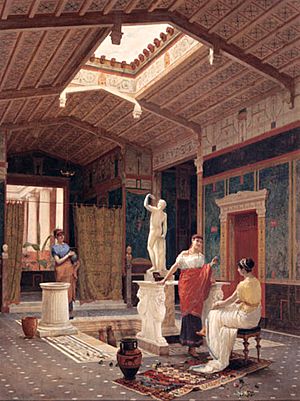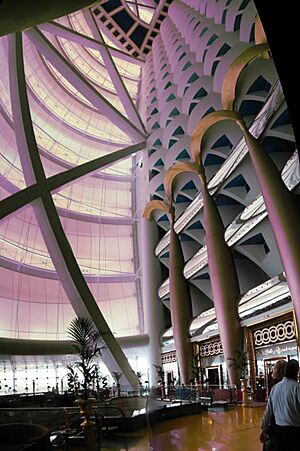Atrium (architecture) facts for kids
An atrium (say: AY-tree-um) is a big, open space inside a building. It often has a glass roof or large windows. Atria make buildings feel open and full of light. They are popular because they create a bright, exciting indoor area that still connects you to the outside world. Architects enjoy designing them, and builders find they make buildings more appealing.
Ancient Atria

In ancient Roman architecture, an atrium was a common part of a large house called a domus. It was an open central courtyard with rooms all around it.
In the middle of the atrium, there was a shallow pool called an impluvium. This pool collected rainwater that came through an opening in the roof above it. These pools were sometimes beautifully decorated.
The atrium was the most important room in a Roman house. It often had a marble table, a small chapel for family spirits, a household safe, and sometimes a statue of the house's owner.
The word "atrium" was also used for open spaces in public and religious buildings, like courtyards with arches. Many Byzantine churches and mosques have similar open areas at their entrance.
19th Century: Glazed Atria
The 1800s brought big changes with the Industrial Revolution. New ways to make iron and glass meant that courtyards could now have glass roofs. This kept out bad weather and led to the modern atrium we see today.
-
Victoria Hall in Halifax Town Hall, 1863
-
The atrium at the center of the Bradbury Building in Los Angeles
Modern Atria
Today, atria are often many floors tall and are found near the main entrance of buildings. They are a key feature in many modern designs.
One important thing about modern atrium design is fire safety. Designers must make sure that atria do not allow fire to spread quickly to upper floors. A downside of atria is that they use up vertical space that could otherwise be used for more floors.
Some famous modern atria include:
- The Atrium at Federation Square in Melbourne, Australia. It is a street-like space, five stories high, with glass walls and a roof.
- The Opryland Hotel in Nashville, Tennessee, U.S. It has four huge atria, covering about 9 acres (36,000 m²) with glass ceilings over gardens.
- The Burj Al Arab hotel in Dubai has the world's tallest atrium, which is 180 meters (590 ft) high.
- The Luxor Hotel in Las Vegas, Nevada, has the largest atrium in the world by volume.
Images for kids
-
Roman atrium of the building of the baths in the Roman villa of "Els Munts", close to Tarraco
-
The atrium of 1 Bligh Street, a Sydney office tower, looking upwards
-
Looking up inside the 32-story atrium of the Shanghai Grand Hyatt, part of the Jin Mao Building
-
Atrium of the New York State Theater at Lincoln Center
-
Four floor atrium of Gould Hall, College of Architecture and Urban Planning, at the University of Washington
-
The Grand Doubletree hotel/condo in Downtown Miami 42 story atrium
-
Atrium of Complexe Desjardins, Montreal
-
Atrium of Kurayoshi Park Square in Kurayoshi, Japan
-
Multi-floor atrium with three see-through octagonal elevator shafts in Water Tower Place in Chicago
See also
 In Spanish: Atrio para niños
In Spanish: Atrio para niños


















